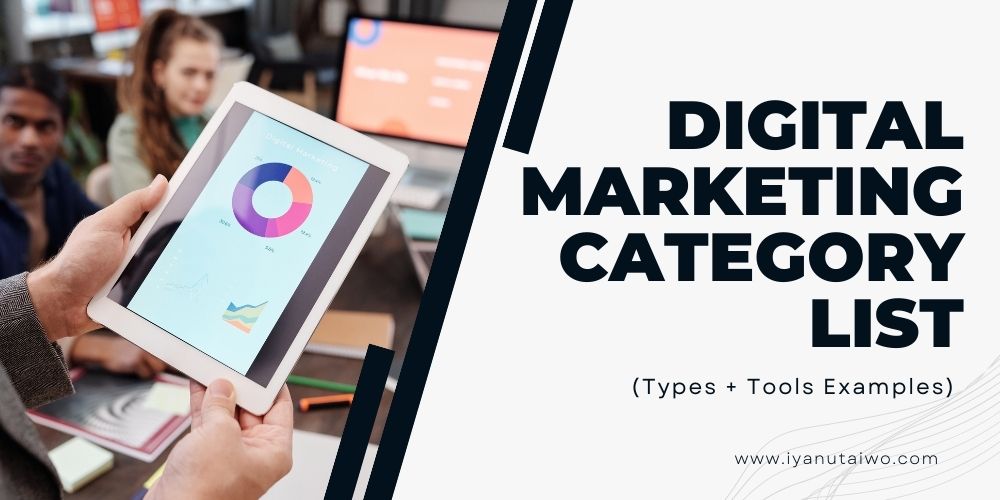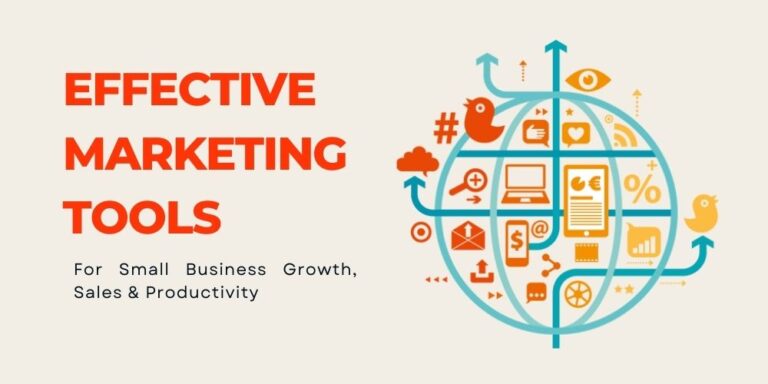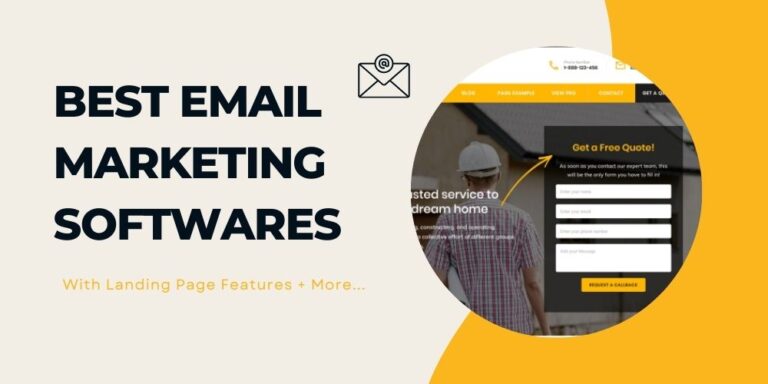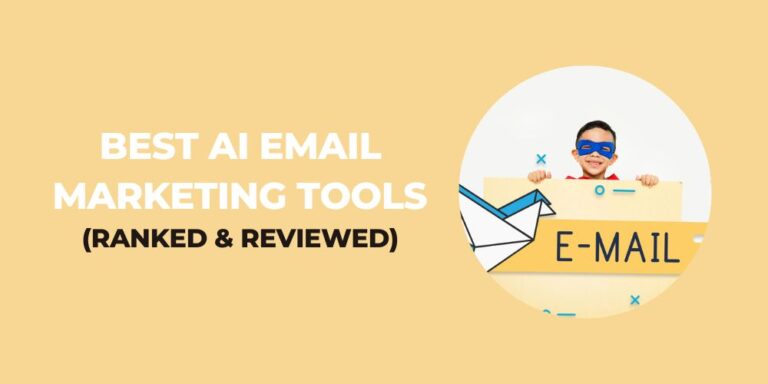Digital Marketing Category List (Updated 2024 List W/ Examples)

Welcome to the 2024 digital marketing category list.
Here you’ll see a comprehensive list of the top digital marketing categories in the industry including the top tools under each category.
Whether you’re a seasoned digital marketer or just getting started, this post is for you.
This list is to help you stay ahead of the game and understand the different ways to use digital marketing to grow your business.
Let’s dive in!
Table of Contents
What is Digital Marketing?
Digital marketing focuses on promoting a product or service through digital channels like the Internet, social media, and mobile devices.
According to a survey done by Salesforce in 2022, digital marketing is becoming more and more crucial for companies of all sizes.
Demandsage reports that by 2026, it is expected that the digital marketing sector will generate $807 billion.
One of the main benefits of digital marketing is its capacity to inexpensively reach a huge, worldwide audience.
Reaching a target audience, engaging with them, raising brand awareness, and encouraging conversions are the objectives of digital marketing.
Additionally, businesses can target specific audiences using demographic, interest, and behaviour data.
Digital marketing covers a wide range of tactics, such as search engine optimization (SEO), pay-per-click (PPC) advertising, social media marketing, and more (which are further explained).
Also Read: 63+ Effective Marketing Tools For Small Businesses
What Are The Digital Marketing Category List?
1. Search Engine Optimization (SEO)
Let’s talk about SEO on the digital marketing category list.
SEO involves the optimization of a website for search engine results pages (SERPs) is known as search engine optimization (SEO).
Businesses can use SEO to target particular keywords and phrases that are relevant to their goods or services and connect with prospective customers who are actively looking for those keywords.
Among the advantages of SEO are improved brand awareness, higher conversion rates, and increased visibility and website traffic.
Top SEO Tools:
- Google Analytics: Provides detailed website traffic data and insights for informed decision-making.
- Semrush: Offers a comprehensive suite of tools for conducting market and keyword research, tracking competitors, and monitoring online visibility.
- Ahrefs: Known for its powerful backlink analysis capabilities, allowing users to identify and target high-quality link-building opportunities.
- Moz: Offers a range of SEO tools including keyword research, link building, and site audits for improving search engine visibility.
- Serpstat: A versatile platform for SEO, PPC, and content marketing, featuring keyword research, site audit, and competitor analysis tools.
Also Read: Best SEO Software For Small Businesses
2. Pay-per-click (PPC) advertising
With PPC, businesses are charged for each click on their ads. For companies of all sizes, pay-per-click (PPC) advertising is a highly effective way to quickly draw relevant traffic to a website.
You can target particular demographics, places, and even specific times of day with PPC advertising.
PPC offers the advantages of quick outcomes, audience targeting, and campaign tracking and evaluation.
Top PPC Ads Platforms:
- Bing Ads: Reach a different audience by advertising on Bing, which has a slightly different user demographic than Google.
- Google Ads: Advertisers can reach users at the moment they are searching for products or services similar to those being offered.
- Facebook Ads: Target specific demographics and interests, such as age, location, and behaviour, to reach a highly-relevant audience.
- LinkedIn Ads: Advertise to a professional audience and reach decision-makers in specific industries and job titles.
- Twitter Ads: Reach users in real-time through promoted tweets and targeted advertising options.
- TikTok Ads: Reach a young and engaged audience through creative, short-form video ads that can be customized to fit the platform’s unique format.
3. Social media marketing
This entails utilizing social media websites to advertise a good or service. Social media marketing can assist companies in reaching a large audience, and it is an excellent way to increase brand recognition and website traffic.
Among the advantages of social media marketing are better customer engagement, increased website traffic, brand awareness, and the ability to monitor and evaluate campaign outcomes.
Social media marketing tools:
- Hootsuite – allows for scheduling and publishing of posts across multiple social media platforms from one central location.
- Buffer – Offers a simple and user-friendly interface for scheduling and publishing posts, as well as a suite of analytics tools to track performance.
- Sprout Social – Provides advanced analytics and reporting, as well as a robust set of engagement tools for responding to messages and comments across social media platforms.
- Later – Specializes in Instagram marketing, offering scheduling and publishing tools, as well as analytics and a feature for finding and engaging with relevant hashtags and influencers.
- Agorapulse – Offers a comprehensive set of tools for social media management, including scheduling, publishing, analytics, and engagement, as well as a feature for managing and responding to reviews on platforms like Yelp and Google.
Also Read: Social Media Advertising Tips For Local Businesses
4. Content marketing
This requires the creation and distribution of valuable, useful, and consistent information in order to draw in and engage a certain target audience.
Through the use of content marketing, it is possible to boost lead generation, website traffic, and brand exposure.
The benefits of content marketing include increased exposure, better customer contact, and the opportunity to monitor and assess campaign performance.
You can’t ignore content marketing on this digital marketing category list.
Content Marketing Tools
- Buzzsumo: Allows users to track and analyze the performance of content across various social media platforms.
- CoSchedule Headline Analyzer: A tool that analyzes the headlines of blog posts and articles to provide suggestions for improvement in terms of length, word choice, and sentiment.
- Canva: A graphic design tool that makes it easy to create visually appealing graphics, infographics, and other types of content to complement written pieces.
- BuzzStream: A tool for content promotion and link building, it allows users to streamline the process of reaching out to them for content promotion and link-building opportunities.
- Grammarly: A writing tool that helps you improve the quality of your writing and eliminate errors. It checks your grammar, punctuation, and style, and provides suggestions for improvement.
5. Email marketing
Email marketing is the practice of sending promotional emails to a list of subscribers. Brands can increase brand recognition, boost revenue, and nurture leads by sending targeted, individualized messages to potential clients.

Email marketing can also be used to communicate with existing clients, offer useful information, and foster client loyalty.
Businesses may measure the success of their email marketing activities and make improvements to increase ROI by tracking open and click-through rates.
Top Email Marketing Tools:
- GetResponse: An all-in-one platform that offers email marketing, landing pages, webinars, and marketing automation.
- AWeber: An email marketing platform that offers a wide range of features, including automation, list segmentation, and detailed analytics.
- Constant Contact: A comprehensive email marketing solution that offers a wide range of features, such as customizable email templates, automation, and integrations with popular e-commerce platforms.
- Mailchimp: A user-friendly email marketing tool that offers a wide range of features, including email design templates, automation, and analytics.
- Campaign Monitor: Offers a wide range of features, including automation, list segmentation, and detailed analytics.
Also Read:
- 7+ Best AI Email Marketing Tools (Ranked & Reviewed)
- 21+ Best Email Marketing Software With Landing Pages
6. Influencer marketing
This is one kind of marketing that places a strong emphasis on using important people to bring your brand’s message to a wider audience.
Instead of directly promoting a product to a huge consumer base, influencers are encouraged, hired, or paid to spread the word on your behalf.
This form of marketing, which has a high chance of success, makes use of the consumers’ perceptions of the influencer’s credibility and trust.
By engaging with influencers in their sector, businesses can raise brand awareness and reach a larger audience.
Influencer Marketing Tools:
- AspireIQ: A platform that helps brands identify and collaborate with influencers across social media platforms.
- Upfluence: A platform that uses AI to help brands identify and engage with influencers on social media platforms.
- BuzzSumo Influencers: A tool that allows brands to search for and analyze influencers by topic, audience size, and engagement levels.
- Klear: A platform that helps brands discover and connect with influencers across multiple social media platforms. It also provides detailed analytics of influencer’s performance and engagement.
7. Affiliate marketing
Affiliate marketing is a performance-based marketing strategy in which a company compensates one or more affiliates for each visitor or customer generated by the affiliate’s own marketing efforts.
Affiliates typically promote a business through their own personal networks and websites and are compensated for each sale or lead they generate.
This type of marketing can be extremely effective because it allows businesses to access large networks and audiences while only paying for results.
Affiliate Marketing Software / Platforms:
- Commission Junction: A well-established affiliate network that connects businesses with a large network of publishers, allowing them to run affiliate programs and track commissions.
- LinkTrust: A comprehensive affiliate tracking software that offers real-time reporting, advanced fraud detection, and customizable commission structures.
- ShareASale: A popular affiliate network that connects businesses with a large network of publishers, and offers a wide range of tools for managing affiliate programs and tracking commissions.
- Tapfiliate: A cloud-based affiliate marketing software that offers advanced tracking, reporting, and commission management tools, as well as customizable forms for recruiting new affiliates.
- Skimlinks: A content monetization platform that automatically converts product links in a website’s content into affiliate links, allowing publishers to earn commissions on sales.
8. Video Marketing
Video marketing is one of the popular types of digital marketing that involves using video content to advertise a good or service.
By producing interesting and educational videos, businesses may raise their visibility, increase website traffic, and boost conversion rates.
Video marketing can be done on a variety of platforms, including YouTube, Vimeo, and Facebook.
Businesses can measure the effectiveness of their video campaigns and make adjustments to improve their ROI by tracking views, engagement, and conversions.
Video Marketing Platforms:
- Wistia: Offers a range of features for creating and promoting videos, including video analytics, lead generation tools, and the ability to add calls to action and forms to videos.
- Vimeo: Offers advanced privacy options, analytics and a suite of tools for businesses and marketers, such as lead generation and e-commerce capabilities.
- YouTube: The largest video-sharing platform, which offers a wide range of free tools for creating, editing and publishing videos, as well as analytics, audience engagement, and advertising options.
- Animoto: A video creation tool that allows users to easily create professional-looking videos using a wide variety of customizable templates, as well as video analytics and social media sharing features.
- Vidyard: Allows businesses to host, manage and track video content, it provides insights on viewer engagement and allows for personalization and automation of video communication
9. Display advertising
Display advertising is a type of online advertising that promotes a product or service by using banners or graphic ads.
Businesses may analyze the efficacy of their display ad campaigns and make adjustments where needed to maximize their ROI by tracking impressions and click-through rates.
Display advertising can be targeted at specific audiences based on their demographics, interests, and behaviours and can be displayed on a variety of websites, blogs, and social media platforms.
Popular Displaying Ads Solutions:
- Google Display Network (GDN): One of the most widely used display advertising platforms, allows you to place ads on a vast network of websites and apps across the internet.
- Bing Ads: A platform for creating and managing display ads that appear on the Bing search engine and the Bing Display Network of websites.
- Outbrain: A content discovery platform that uses machine learning algorithms to suggest personalized content and sponsored articles to users. It allows advertisers to target specific audiences and measure engagement with their ads.
- The Trade Desk: Platform allows you to buy and manage display advertising on various exchanges, and access to a variety of data and targeting options.
10. Mobile Marketing
On our digital marketing category list is mobile marketing.
This has become a crucial component of every digital marketing strategy. All thanks to the increasing use of smartphones and tablets.

Mobile marketing channels include SMS, mobile applications, and mobile web. Businesses may evaluate engagement and conversions to determine the effectiveness of their mobile ads and make changes to boost their ROI.
Mobile Marketing Tools:
- Appboy: Offers a comprehensive platform for mobile app marketing, including push notifications, in-app messaging, and automation tools.
- Leanplum: A mobile marketing platform that provides personalization and messaging capabilities, A/B testing, and automated campaigns.
- Airship: A mobile engagement platform that offers push notifications, in-app messaging, and automation tools to drive customer engagement.
- Localytics: A mobile marketing and analytics platform that provides user segmentation, push notifications, in-app messaging, and a range of analytics and reporting tools.
- CleverTap: Offers a mobile marketing automation platform that enables personalization, push notifications, in-app messaging, and analytics. It also includes a feature for user retention and re-engagement.
11. E-commerce marketing
When you talk about E-commerce marketing, you’re referring to the online promotion and sale of goods or services. With the increasing popularity of shopping, e-commerce marketing has emerged as an essential component of any digital marketing strategy.
Top Ecommerce Marketing Platforms:
- Shopify: Known for its ease of use and user-friendly interface, Shopify allows small and medium-sized businesses to set up and manage an online store quickly and efficiently.
- BigCommerce: This platform offers a wide range of features, including built-in SEO tools and integrations with various third-party apps. It also allows for scalability for businesses that anticipate high-volume traffic and sales.
- Magento: Magento is an open-source platform that is highly customizable, making it a popular choice for larger businesses and enterprise-level organizations.
- WooCommerce: It’s a free, open-source plugin for the WordPress platform. It offers a wide variety of plugins and themes, which makes it easy to add functionality and design to your e-commerce website.
- Salesforce Commerce Cloud: It also allows for seamless integration with other Salesforce products, making it a great choice for companies that are already using Salesforce for other parts of their business.
12. Local SEO
Local SEO is the process of optimizing a business page or website so that it appears higher in search engine results pages for local search queries.
Local businesses can attract more leads, conversions, and sales by knowing how search engines work and what people are searching for in a specific location.
Local SEO can be accomplished through a variety of methods, including the creation of local listings, the development of local backlinks, and the optimization of meta tags. .
best Local SEO Platforms:
- Google Business Listing: Allows businesses to manage their online presence across Google, including search and maps.
- Moz Local: Helps businesses ensure their information is accurate and consistent across all local directories and search engines.
- Yext: Allows businesses to manage their information across a network of publishers, including search engines, social media, and mapping services.
- BrightLocal: A local SEO platform that offers a suite of tools including citation tracking, review generation, and local keyword research.
- Whitespark Local Citation Finder: A tool for finding and tracking local business citations, which are mentions of a business’s name, address, and phone number on other websites.
Also Read: How To Start A Small Business From Scratch
13. Voice search optimization (VSO)
Who would have thought that voice search optimization will rank so fast in the digital marketing category list?
But with the growing popularity of voice assistants like Siri and Alexa, voice search optimization has become an essential component of any digital marketing strategy.
Voice search optimization can be accomplished through a variety of methods, including the development of long-tail keywords, the optimization of meta tags, and the creation of FAQ pages.
Voice Search Optimization Solutions:
Voiceflow: A platform that allows users to design, prototype, and build voice apps for Amazon Alexa and Google Assistant. It also offers analytics and optimization tools to improve the performance of voice apps.
Voice SEO plugins: A WordPress plugin that helps optimize a website for voice search by automatically adding schema markup and optimizing meta tags. It also provides insights into voice search queries and competitor analysis.
14. Web analytics
Web analytics is the practice of analyzing data from a website in a bid to comprehend user behaviour and track the efficiency of a website.
Businesses may assess the efficacy of their website and digital marketing strategies by tracking website traffic, bounce rate, and conversions.
Web Analytics Tools:
- Google Analytics: A free web analytics service offered by Google that tracks and reports website traffic. It provides detailed data on website visitors, including demographics, behaviour, and conversion tracking.
- Adobe Analytics: A powerful web analytics solution that provides in-depth data on website visitors, including real-time data, cross-channel attribution, and advanced segmentation.
- Piwik: A open-source web analytics platform that allows you to host your own data and provide detailed data on website visitors, including custom variables, heatmaps, and real-time data.
- Mixpanel: An analytics platform that tracks user behaviour across mobile and web, allowing you to understand how users interact with your product and identify opportunities for growth.
- Omniture: A web analytics platform that provides deep insights into customer behaviour and marketing performance, including advanced segmentation, visitor profiling, and conversion tracking.
Also Read: 21+ Best Customer Analytics Software
15. Landing page optimization (LPO)
Landing page optimization is the practice of improving the conversion rate of a website’s landing page.
Landing page optimization methods include A/B testing, creating enticing headlines, and improving forms. Businesses that can track conversions can improve the performance of their landing pages and increase their ROI.
Top Landing Page Creation & Optimization Tools:
- Elementor: A powerful visual website builder, Elementor offers a variety of design options and widgets, with drag-and-drop editing, allowing users to create landing pages with ease.
- Unbounce: Allows for easy A/B testing and customizable templates.
- Leadpages: Offers a wide range of integrations and a user-friendly drag-and-drop builder.
- Instapage: Provides advanced analytics and heatmaps to track user behaviour.
- OptimizePress: Focuses on conversion rate optimization and integration with popular marketing tools.
- Landingi: Offers dynamic text replacement and built-in form validation to improve conversion rates.
16. Remarketing
Retargeting and remarketing are advertising techniques that target people who have previously interacted with a company’s website.

Businesses may enhance brand awareness and drive conversions by retargeting and remarketing ads to consumers who have previously expressed interest in a product or service.
Remarketing Solutions:
- Google AdWords Remarketing: A popular and widely used tool, Google AdWords remarketing allows you to target previous website visitors with personalized ads as they browse other websites.
- Facebook Custom Audiences: You can create custom audiences based on website visitors, app users, and engagement, and target them with personalized ads on the Facebook platform.
- Perfect Audience: Custom audiences, conversions tracking, and optimization across devices/platforms.
- AdRoll: Cross-device retargeting with dynamic product ads, segmentation, and conversion tracking.
- RetargetLinks: Retargeting tool for email marketers. Turns links into retargeting pixels to target website visitors from email campaigns.
17. Chatbot marketing
Chatbot marketing is the process of interacting with customers and providing them with information using chatbots.
Chatbot marketing can be done on multiple platforms, including Facebook Messenger, WhatsApp, and WeChat.
Businesses can analyze the efficacy of their chatbot initiatives and make adjustments to increase their ROI by tracking engagement and conversions.
Chatbot Marketing Solutions:
- MobileMonkey: Advanced targeting and segmentation options, built-in lead generation and opt-in forms supports multiple chatbot types.
- Chatfuel: Easy-to-use interface and strong analytics.
- Chatbotify: AI-powered chatbot, customizable chatbot templates, supports multiple languages
- ManyChat: User-friendly interface, drag-and-drop bot-building feature, easy integration with Facebook and WhatsApp.
- Tars: Advanced analytics and tracking, customizable bot flows, supports multiple platforms including WhatsApp.
- Pure Chatbot: Multi-language support, Lead generation and qualification, easy integration with various CRM.
18. Virtual reality marketing (VRM)
Virtual reality marketing is the act of promoting a product or service via the use of virtual reality technology. Businesses can analyze the efficacy of their virtual reality marketing and make adjustments to increase their ROI by tracking engagement and conversions.
Top Virtual Marketing Tools:
- Oculus: Offers high-quality, immersive VR experiences and is widely used in gaming and entertainment industries.
- Vuforia: Allows marketers to create augmented reality experiences that can be integrated with print materials, product packaging, and in-store displays.
- VeeR: Specializes in VR content creation and distribution, with a focus on 360-degree video and VR storytelling.
- WebVR: An open-source JavaScript API for creating VR experiences that can be accessed directly from a web browser.
- Unity: A popular game engine that allows developers to create interactive VR experiences, and also supports AR and 3D development.
19. Native advertising
Native advertising is a type of marketing that is incorporated into a website’s or platform’s content. Businesses can evaluate the success of their native ad campaigns and make changes to increase their ROI by tracking engagement and conversions.
Top Native Advertising:
- Outbrain: Offers access to high-quality, premium content sites and uses data and user engagement to target the right audience at the right time.
- Taboola: Uses machine learning to personalize content recommendations and provides a range of targeting options.
- Revcontent: Allows for targeting specific audience segments and provides detailed analytics and reporting.
- Sharethrough: Provides in-depth analytics and reporting, it uses a proprietary algorithm to optimize ad performance and provide detailed metrics.
- Media.net: Offers a range of ad formats such as in-feed, in-article, and recommended content units that blend seamlessly with content and targeting options based on keywords, interests, and demographics.

20. Programmatic advertising
The automated buying and selling of digital advertising are known as programmatic advertising. Through a variety of platforms, including Google AdWords, Facebook Ads, and Twitter Ads, programmatic advertising can be carried out.
Businesses can evaluate the success of their programmatic marketing campaigns and make changes to increase their ROI by being able to track conversions and engagement.
Programmatic Advertising Platforms
- Google Ads: Offers a wide range of targeting options, including keyword, demographic, and interest-based targeting.
- Facebook Ads: Allows advertisers to reach specific audiences using a variety of targeting options, including demographics, interests, and behaviours.
- Twitter Ads: Offers targeting options based on keywords, interests, behaviours, and audience segments.
- AppNexus: Platform for buying and selling online advertising, with advanced targeting options, private marketplaces and real-time bidding capabilities.
- The Trade Desk: Offers a wide range of targeting options, including demographic, geographic, and device-based targeting, as well as access to a wide range of inventory sources, including exchanges and private marketplaces.
Digital Marketing Category List: Summary
I hope you enjoy the digital marketing category list.
Digital marketing is a vast field that encompasses various strategies and techniques to promote a business or brand online.
Each category has its own unique importance and benefits that can help businesses reach and engage with their target audience, increase brand awareness, and drive conversions.
In summary, digital marketing is a form of marketing that utilizes digital channels to reach and engage with a target audience, increase brand awareness, and drive conversions.
As technology continues to evolve and more people access the internet, digital marketing will become increasingly important for businesses of all sizes. The statistics show that digital marketing is expected to grow in the next years, which is why it’s important to invest in it.






